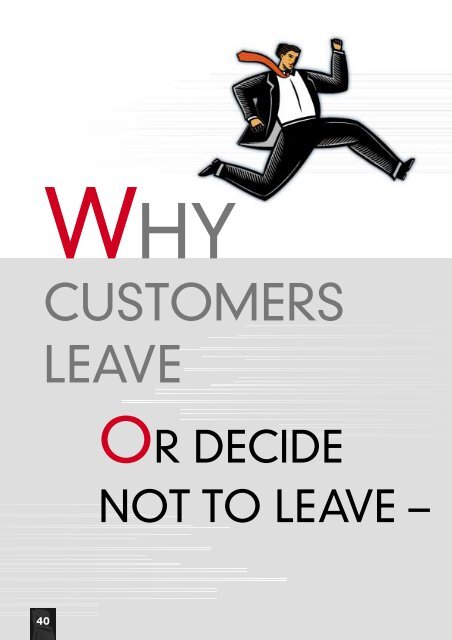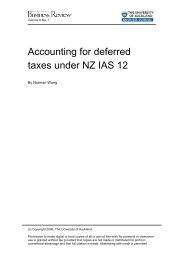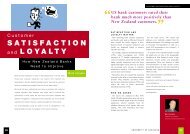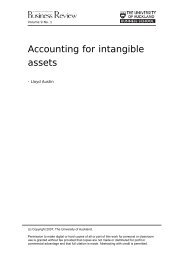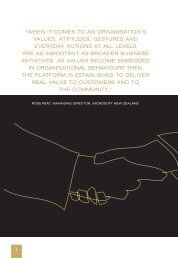CUSTOMERS LEAVE - University of Auckland Business Review
CUSTOMERS LEAVE - University of Auckland Business Review
CUSTOMERS LEAVE - University of Auckland Business Review
- No tags were found...
You also want an ePaper? Increase the reach of your titles
YUMPU automatically turns print PDFs into web optimized ePapers that Google loves.
WHY<strong>CUSTOMERS</strong><strong>LEAVE</strong>OR DECIDENOT TO <strong>LEAVE</strong> –40
Much research has focusedon how to improve a service provider’s quality<strong>of</strong> service and how to attract and maintaincustomers (particularly with the use <strong>of</strong> servicerecovery techniques).A major factor that affects customers’perception <strong>of</strong> a service provider is the numberand extent <strong>of</strong> the problems they encounter andhow these problems are handled.A problem a customer has with a service canbe called a “service failure”. When customersencounter a service failure, they can either notcomplain, or complain and give the serviceprovider an opportunity to rectify the problem.If they do not complain, they may remain withthe provider, despite their dissatisfaction, or exit.If they do complain, they may also choose tostay or leave, and this is influenced by how thesituation is handled by the service provider (i.e.the service recovery).Service recovery includes all actions takenby a service provider to try to resolve acustomer’s problem.There is a strong focus in the literature onmanagerial ways to improve service recovery.For example, much research looks at whataspects <strong>of</strong> service recovery encourage acustomer to stay. This plethora <strong>of</strong> literatureleads us to believe that service recovery is themost important factor in driving a customer toexit or stay after a service failure. This, however,is not the case.The aim <strong>of</strong> this paper is to generate a model <strong>of</strong>how customers react to service failure by gaininga more detailed understanding <strong>of</strong> what drives acustomer to remain or exit after a service failure.It is important that we compare customers inthe same service context (i.e. same industry andsame segment <strong>of</strong> customers) so that we obtainmore comparative results. The extant literaturedoes not investigate this area fully, but insteadtends to focus on one dimension <strong>of</strong> this researchfield (e.g. service recovery or exit).This leads us to the research question: Why dosome customers exit their service provider aftera service failure, while others stay?▼THEIR BANKBY MARK COLGATEAND MELISSA NORRISUNIVERSITY OF AUCKLAND<strong>Business</strong> <strong>Review</strong>Volume 2 Number 2 200041
Spurious loyalty … has beenneglected by managersand academics alikeThis paper is broken down as follows:• An examination <strong>of</strong> the literature on all aspects<strong>of</strong> service failure.• Propositions for the study, based on theliterature review.• The results <strong>of</strong> interviews with customers whohave stayed after a service failure and withcustomers who have exited.• Development <strong>of</strong> a model, based on theresults <strong>of</strong> the interviews, that aims to presenta more complete picture <strong>of</strong> the outcomes <strong>of</strong>service failure.• Implications <strong>of</strong> this research, both academicand managerial.SERVICE FAILUREThe differing reactions customers may haveto service failure have been discussedthroughout the literature. These include loyalty,voice (e.g. complaining to the service provideror another party) and exit.LOYALTYA service provider develops loyalty overtime by consistently meeting, and sometimesexceeding, customer expectations.Loyal customers are good for business. They“<strong>of</strong>ten cost less to service, spend more as theirtime with the firm lengthens and provide agood source for new business” (Levesque andMcDougall, 1993: pg 40). Customer loyaltyusually leads to lower marketing costs, moreefficient operations and higher pr<strong>of</strong>its.Loyalty comes in several differing forms,including pure loyalty, latent loyalty andspurious loyalty (Dick and Basu, 1994).Pure loyalty is patronising a company <strong>of</strong>ten aswell as thinking highly <strong>of</strong> it. This is the kind <strong>of</strong>loyalty most people associate with the term.Latent loyalty is when a customer has lowrepeat patronage, but thinks highly <strong>of</strong> theorganisation.Finally, spurious loyalty is the opposite – acustomer has high repeat patronage, but arelatively low opinion <strong>of</strong> the company.Hirschman (1970) describes this as “remainingwith a company despite dissatisfaction”. It isthis notion <strong>of</strong> spurious loyalty that is <strong>of</strong> themost interest as it has been neglected bymanagers and academics alike.Initially, the choice by a spuriously loyalcustomer to remain with a provider does notthreaten pr<strong>of</strong>its, but with continueddissatisfaction they may spread negative word<strong>of</strong>-mouthor exit (Hirschman, 1970).Companies need to understand why acustomer still patronises them, as it may notnecessarily be a positive, conscious choice.Customers may stay with an organisation evenif they are dissatisfied because they perceivethey have no choice. Hence, a “loyal” customermay not necessarily be a satisfied customer.The findings from a study conducted byLevesque and McDougall (1993: pg 52)suggested that “even when a problem is notsolved, approximately half <strong>of</strong> the respondentswould remain with the firm”. This may be due toswitching costs, lack <strong>of</strong> perceived differentiation<strong>of</strong> alternatives, locational constraints on choice,time or money constraints, habit or inertia.Hirschman (1970) also proposes thatdissatisfied customers may choose to remainwith a service provider because they think thatthe likelihood <strong>of</strong> an improvement outweighs thecost <strong>of</strong> searching for another supplier.The literature suggests, then, that loyalty isone <strong>of</strong> the responses a customer makes to aservice failure. But we should not believe thatloyalty is one-dimensional. Customers may staywith a service provider because they generallyhave a high opinion <strong>of</strong> the provider and see theservice failure as an aberration. Or they may bespuriously loyal – they feel trapped, areapathetic or feel that there are no alternatives.42
W HY <strong>CUSTOMERS</strong> <strong>LEAVE</strong> – OR DECIDE NOT TO <strong>LEAVE</strong> – THEIR BANKVOICEThe terms “voice” and “exit” wereintroduced by Hirschman (1970) when hesuggested that dissatisfaction can provoketwo active negative responses: voice and exit.Day and Landon (1977) extended thenotion <strong>of</strong> “voice” by explaining that it can becomplaining to the service provider, complainingto acquaintances (negative word <strong>of</strong> mouth), orcomplaining to third parties to seek redress.Any problem a customer has with theirservice provider will arouse some emotion,whether they complain about it to the provideror not. If they do make such a complaint, theygive the service provider a chance to rectify theproblem. A customer must have sufficientlystrong emotions about a situation before theymake an effort to complain, however.High transaction costs are another reasonconsumers choose not to complain. “These[costs] include the time, cost and effortinvolved, uncertainty about how to complain,and beliefs that redress will not be provided”(Day and Landon, 1977).A complaining customergives the companyan opportunityService providers must provide open lines <strong>of</strong>communication if they want customers tocomplain, so they can try to solve their problems.If a customer “voices” by any other means, suchas complaining to a business colleague, or exits,it is difficult for the service provider to find outwhy that customer was unhappy.The literature identifies customercomplaints (or lack <strong>of</strong>) as an integral part <strong>of</strong>service failure. A customer who does notcomplain may either exit and give theAny problem a customerhas with their serviceprovider will arousesome emotionorganisation no chance to “save” thecustomer, or stay and “fester”. Neither isdesirable. But a complaining customer givesthe company an opportunity, which should beseen as such.STAY OR EXIT?A customer’s final decision after a servicefailure is to stay or exit. To exit in response toa service failure, the customer must bemotivated and must expend effort (Singh,1990; Stewart, 1998).Customer exit can cost the seller a great dealthrough decreased income from the customer’sfuture spending, higher costs in attracting newcustomers, loss <strong>of</strong> free advertising through word<strong>of</strong> mouth, and decreased employee retention.The benefits <strong>of</strong> customer retention have alsobeen emphasised. For example, Reichheld andSasser (1990) found that by retaining five percent more customers, a service provider canincrease pr<strong>of</strong>its by almost 100 per cent.Many factors influence a customer’s reactionwhen they face a problem with their serviceprovider. This paper uncovers what thesefactors are and how they interact, leading to thedecision by the customer to leave or stay.SERVICE RECOVERYIf the above reactions to service failure, voice,when it involves complaining to the serviceprovider, creates the potential for the customerand the organisation to resolve the problem.Gronroos (1990) defined service▼UNIVERSITY OF AUCKLAND<strong>Business</strong> <strong>Review</strong>Volume 2 Number 2 200043
If service recovery is not regardedas important or handledwell, customer satisfactioncan be erodedrecovery processes as “those activities in whicha company engages to address a customercomplaint regarding a perceived servicefailure”. It encompasses all the actions taken toget a disappointed customer back to a state <strong>of</strong>satisfaction.Several reasons are posited throughout theliterature for the growing tendency forcompanies to invest in service recovery efforts. Ifservice recovery is not regarded as importantor handled well, customer satisfaction can beeroded. Ultimately, the service provider’spr<strong>of</strong>itability may diminish.Results from Bosh<strong>of</strong>f (1997) support this. Heshowed that poor service delivery cannot becompensated for by great service recovery,although service recovery can help significantly inlimiting the harmful impact <strong>of</strong> poor service delivery.Stewart’s model, although most insightful,focuses solely on a customer’s decision to exit.It needs expansion when applied to the servicefailure process as a whole.Bosh<strong>of</strong>f (1997) introduced a model <strong>of</strong> servicerecovery, not just the customer exit process. Heattempted to bring together all the aspects <strong>of</strong>service recovery identified by earlier authors.The model also depicts, to some extent,customers’ different types <strong>of</strong> reactions todissatisfaction. Customers are broken down into:• Those who have seriously considered leavingthe service organisation and do not complain,but value loyalty, so they stay.• Those who do not complain, but just exit.• Those who do complain and, depending onthe outcome <strong>of</strong> their complaint, either staybecause <strong>of</strong> satisfaction or loyalty, or leave.Despite the importance <strong>of</strong> these models otherresearch suggests they are incomplete. Ourresearch attempts to tie together all thedisparate areas <strong>of</strong> research. Only then can theoutcomes <strong>of</strong> service failure be fully understood.MODELS OF THE SERVICERECOVERY PROCESSTwo models directly relate to this paper:Stewart’s (1998) customer exit process modeland Bosh<strong>of</strong>f’s (1997) service recovery model.Stewart developed a comprehensive model <strong>of</strong>the customer exit process, designed to helpmanagement understand the process. She notesthat customers usually make complaints beforeexit and go through a series <strong>of</strong> emotions.The availability <strong>of</strong> alternatives and therelationship the customer has with the serviceprovider are also considered, as well as thecomplaint handling, before exit is invoked.She suggests that by the time a customer hasdecided to exit an organisation, it is too late torecover them. Often they are leaving because <strong>of</strong>the organisation’s lack <strong>of</strong> responsiveness. If theorganisation does respond when they havedecided to leave, this is viewed as ironic.SERVICE FAILURE OUTCOMESAcustomer may stay after experiencing aproblem because they have complainedand they are satisfied with the service recoveryprocess. This is the ideal situation for serviceproviders who plan for good service recovery.Many times, however, customers stay eventhough they are dissatisfied with the servicerecovery they have received. This spuriousloyalty may result from a customer’s perceptionthat the barriers to exit are high and/or that thequality <strong>of</strong> alternative providers is no better.The spuriously loyal are “prospective switchers”.Given a change in the rules (e.g. more alternativescome along), they may leave immediately.The other outcome, when a customer experiencesa service failure, is to leave. They may havecomplained, but the service provider’s recoveryefforts may have been poor, causing the customerto be even more dissatisfied and leave.44
W HY <strong>CUSTOMERS</strong> <strong>LEAVE</strong> – OR DECIDE NOT TO <strong>LEAVE</strong> – THEIR BANKAlternatively, the customer could besatisfied with the recovery they havereceived, but still exit. This could be due toa perceived lack <strong>of</strong> barriers to exit, a sense<strong>of</strong> apathy about which provider they use,variety seeking, or the feeling that therecovery could not make up for theproblem they have experienced.Hence, service recovery may not be the mainreason why a customer remains or exits.Furthermore, service providers do not alwaysget the opportunity to conduct service recovery,as they are not always aware that a problem hasoccurred. A customer may experience a problem,not complain, and stay. This could be because<strong>of</strong> loyalty towards their service provider, orspurious loyalty. Or a customer may leavewithout complaining.In light <strong>of</strong> the literature review, six propositionsare presented:P 1 = Customers exit without complaining, thus<strong>of</strong>fering the service provider no chance toconduct service recovery.P 2 = Customers exit after they have complained,because they have received poor service recovery.P 3 = Customers exit after they have complained,even though they have received good servicerecovery.P 4 = Customers stay with a service providereven though they encountered a service failureand did not complain.P 5 = Customers stay with a service providerService providers are notalways aware that aproblem has occurredwhen they complained and received goodservice recovery.P 6 = Customers stay with a service providereven though they complained and receivedpoor service recovery.These can been seen in Figure 1.METHODOLOGYQualitative research is the most appropriatefor these propositions. Research into theservice failure process is inconclusive andadditional outcomes <strong>of</strong> service failure mayexist, given the absence <strong>of</strong> research in this area.Also, quantitative research does not allowcustomers to express their true feelings about asituation, so it may not be possible tounderstand what has really happened withoutthe use <strong>of</strong> qualitative research.We looked at small-business customers <strong>of</strong> thebanking industry. Banking for this group has astrong relationship/loyalty aspect to it, makingthe customer’s decision to exit a harder, morethought-involving process.▼FIGURE 1ProblemExitRetentionP 1 NoComplaintP 2 - PoorServiceRecoveryP 3 - GoodServiceRecoveryP 4 - NoComplaintP 5 - GoodServiceRecoveryP 6 - PoorServiceRecoveryUNIVERSITY OF AUCKLAND<strong>Business</strong> <strong>Review</strong>Volume 2 Number 2 200045
There was a general feeling<strong>of</strong> dissatisfaction withthe banks’ servicerecovery effortsAs well, small-business customers are arelatively unresearched group, making thefindings from this research more important.Narrowing down our focus made it easier tocollect data.Respondents fall into two different groups:those who left their bank after a service failureand those who remained with their bank afterseriously considering leaving (a service failurehad to have occurred).We adopted Stewart’s (1998) definition (witha slight revision), so that to leave meant thatthe customer had shifted their main account toanother provider. A main account is defined as“the account where most <strong>of</strong> your transactionstake place”.Those who remained but seriouslyconsidered leaving still kept their main currentaccount and did most <strong>of</strong> their transactions withthe service provider. The problem did notadversely affect the amount <strong>of</strong> business theyhad with that provider.Most <strong>of</strong> the studies conducted to date aboutservice failure tend to ask behaviouralintentions questions. They ask what customersexpect will happen in a service failure situation.It has been proven that this style <strong>of</strong> researchdoes not accurately reflect what customersactually do when faced with the problem.Therefore, this study investigates those customerswho have actually remained or exited.Twenty respondents were selected. Ten hadleft their service provider recently afterexperiencing a service failure and 10 hadremained after recently experiencing a servicefailure and seriously considering leaving.We conducted face-to-face in-depth interviewswhich had been arranged over the telephone. Atotal <strong>of</strong> 435 small businesses were telephonedand if there was no reply or the contact was busy,up to three call-backs were made. A stratifiedrandom sample (by <strong>Auckland</strong> region) was usedand the companies were selected from a smallbusinessdatabase purchased from a third party.Approximately one in 16 companies contactedhad encountered at least one service failure largeenough to make them seriously consider leaving oractually leave their bank. Out <strong>of</strong> those companies,one in four refused to participate in the research.The results from these interviews weretranscribed and then the content analysed usinga number <strong>of</strong> methods, including checklistmatrices, “eyeballing” and searches in NUDIST(a s<strong>of</strong>tware program).RESULTSTHE “REMAIN” GROUPThe majority <strong>of</strong> the respondents in the“remain” group were emotional about theservice failure they had experienced and this ledeight out <strong>of</strong> 10 to complain to the bank. Therewas a general feeling <strong>of</strong> dissatisfaction with thebanks’ service recovery efforts.Of the eight respondents who gave their bankan opportunity to conduct service recovery,only three were satisfied with the recovery. Eventhen, they were still not entirely satisfied, butacknowledged that the bank had made aconcerted effort to rectify the situation.More than half <strong>of</strong> the respondents in the“remain” group felt their relationship with theirbank was not close. The four respondents whohad relatively close relationships tended to havebeen with that bank for more than 10 years andthey expressed moderate to strong levels <strong>of</strong> loyalty.The lack <strong>of</strong> a close relationship with the bankwill have contributed to the low sense <strong>of</strong>loyalty half <strong>of</strong> the respondents in the “remain”group felt towards their bank. This suggeststhat these respondents remained for reasonsother than loyalty.Seven out <strong>of</strong> 10 respondents in this groupperceived high barriers to exit and an46
W HY <strong>CUSTOMERS</strong> <strong>LEAVE</strong> – OR DECIDE NOT TO <strong>LEAVE</strong> – THEIR BANKadditional two perceived moderatebarriers. The barriers mentioned included:the amount <strong>of</strong> time and hassle it wouldtake to change; having to get new chequebooks and transfer funds; and having tolearn a new cash management system.The amount <strong>of</strong> paperwork involved, issueswith existing loans and guarantees and a goodhistory and rapport with their current bankseemed also to be factors. This was accentuatedby the overall feeling by most <strong>of</strong> theserespondents that the alternative banks were <strong>of</strong>the same (or a similar) quality as their own.THE “EXIT” GROUPThe majority <strong>of</strong> the respondents in the “exit”group complained to their bank about thefailure. Only three out <strong>of</strong> the eight whocomplained were satisfied with the recoveryefforts <strong>of</strong> their bank.There appeared to be correlation between thelength <strong>of</strong> time the relationship had existed and thecloseness <strong>of</strong> the relationship. The length <strong>of</strong>relationships between these respondents and theirbanks varied from four to 52 years.Seven <strong>of</strong> the respondents in the “exit” groupperceived the barriers to exit to be low, witheight <strong>of</strong> the respondents indicating thatalternative banks were <strong>of</strong> a marginally orclearly better quality.Finally, the general trend experienced bythis group was to encounter a progression <strong>of</strong>problems over time rather than a singlecritical incident.DISCUSSIONThe literature implies that a direct relationshipexists between service recovery and howcustomers react. If a service recovery is satisfactory,a customer will remain, but if it is unsatisfactory, acustomer will exit. This is not always the case,however, as our results show.Our interviews revealed that three majorfactors influence a customer’s decision toremain or exit after a service failure. These are:Three major factors influencea customer’s decision toremain or exit after aservice failuresatisfaction with recovery (if the customercomplained), loyalty towards the provider, andperceptions <strong>of</strong> barriers to exit. Each <strong>of</strong> these isdiscussed below.SATISFACTION WITH RECOVERYA number <strong>of</strong> customers in the “exit” group leftdespite satisfaction with service recovery and anumber <strong>of</strong> customers in the “remain” groupstayed despite dissatisfaction. This indicatesthat service recovery does not always make adifference.Our results show that if a customer isdissatisfied with recovery they will exit, exceptwhen other factors such as loyalty and barriersto exit are high, enticing the dissatisfiedcustomer to stay.Great service recovery can limit the harmfulimpact <strong>of</strong> service failure, as Bosh<strong>of</strong>f (1997)suggests. Still, factors other than satisfactoryrecovery seem to be more important in drivinga customer’s decision to remain or to exit.Similarly, Stewart (1998) suggests that bythe time a customer has decided to exit anorganisation it is too late to recover them.Even if recovery efforts are satisfactory, thecustomer may exit because they have alreadymade their decision.Our results support the concept that acustomer may receive satisfactory recovery butstill exit. Three <strong>of</strong> the respondents in the “exit”group exited despite satisfactory recovery,implying that they had already decided to exitbefore the recovery was provided.▼UNIVERSITY OF AUCKLAND<strong>Business</strong> <strong>Review</strong>Volume 2 Number 2 200047
Some stay because <strong>of</strong> loyaltyand some because <strong>of</strong>perceived barriers to exitLOYALTYWe found that customers who felt a strongsense <strong>of</strong> loyalty to their bank do not alwaysremain after service failure – although themajority do. When service recovery fails, thedegree <strong>of</strong> loyalty seemed to moderate thecustomer’s decision to exit or stay.This loyalty may result from the customer’sreliance on the relationship they have formedwith the service provider (Gwinner, Gremlerand Bitner, 1998); it may reflect how long therelationship has existed; or it may be that thecustomer feels their provider is giving themthe “best deal”.The results also showed, however, that somepreviously loyal customers still left. Theservice failure is <strong>of</strong>ten strong enough to forcethese customers to leave, despite the strength<strong>of</strong> the relationship.Alternatively, the loyal customers who leftsometimes felt that the bank was notreciprocating their sense <strong>of</strong> loyalty. They leftbecause they had a feeling <strong>of</strong> almost betrayal,especially after many years <strong>of</strong> relationship withthat bank.PERCEIVED BARRIERS TO EXITThe results from this study support the theoryin the literature that if a dissatisfied customer isnot loyal and has a perception that the barriersto exit are low, they will exit rather thanremain. All customers who remained eitherperceived that there were at least some barriersto exit or felt at least a moderate sense <strong>of</strong>loyalty towards their bank.A further dimension <strong>of</strong> barriers to exit is acustomer’s perception <strong>of</strong> alternative providers.We found that a far greater number <strong>of</strong>customers in the “exit” group than in the“remain” group perceived alternative banks tobe <strong>of</strong> a better quality than their current bank.Customers who remained tended to perceive allbanks as the same or other banks as being onlyslightly better.In terms <strong>of</strong> the propositions, evidencesuggests that all are supported, albeit weaklygiven the nature <strong>of</strong> the data. Interestinglythough, new categories seem to exist that werenot fully accounted for in the propositions.Some customers stay after poor servicerecovery because <strong>of</strong> perceived barriers to exitwhile some stay because <strong>of</strong> loyalty. Similarly, <strong>of</strong>the customers who do not complain after aservice failure, some stay because <strong>of</strong> loyalty andsome because <strong>of</strong> perceived barriers to exit.Finally, some customers may exit, even aftergood service recovery, because <strong>of</strong> low levels <strong>of</strong>loyalty (i.e. variety-seeking behaviour) orbecause <strong>of</strong> a perception <strong>of</strong> low barriers to exit.All <strong>of</strong> these categories can be built into amodel <strong>of</strong> customer reactions to service failure,which appears in Figure 2.Most <strong>of</strong> the research into customer retentionand customer exit investigates the processesseparately, not linking the two processes. Bybuilding on the models <strong>of</strong> Stewart (1998) andBosh<strong>of</strong>f (1997) and by incorporating therelevant literature and the summary <strong>of</strong> theresults above, this model shows the differentways customers react to service failure withtheir service provider.EXPLANATION OF THE MODELThere are four concepts in the model thatcover exiting (Boxes 1-4). In the first <strong>of</strong>these, a customer exits without complainingbecause they are dissatisfied. This stems fromthe research that says customers can have twoactive negative reactions to dissatisfaction:voice and exit. In this instance, customers havechosen not to voice and exited instead.The next three exit concepts encompass theidea that if a customer is dissatisfied with aprovider they usually complain in the hope thattheir problem will be resolved (i.e. they hope to48
W HY <strong>CUSTOMERS</strong> <strong>LEAVE</strong> – ORDECIDE NOT TO <strong>LEAVE</strong> – THEIR BANKreceive satisfactory service recovery efforts).Even if a customer is satisfied with recoveryefforts, they may still exit. Sometimes, this isbecause they perceive the barriers to exit to below. A change to an alternative provider is notperceived to be difficult.Other times, the customer may feel littleloyalty to their provider. “A satisfiedcustomer may be willing (or even eager) topatronise alternative suppliers, hoping toreceive even more satisfying results” (Rustand Zahorik, 1993). This implies that thefactors that make a customer loyal aredifferent from those that make them satisfied.The final exit concept refers to the scenariowhen a customer leaves after being dissatisfiedwith the service recovery from their provider. Thismakes sense given that it is the second time theservice provider has failed to meet the customer’sexpectations.The other reaction a customer may have to aservice failure, after seriously consideringleaving, is to remain. The next five concepts(Boxes 5-9) capture the different iterations <strong>of</strong>remaining.If a customer complains, they may remainbecause they are satisfied with the recoverythey have received. The loyalty the customerperceives in the ninth concept is contributingto their decision to remain.Concepts five through to eight are“A satisfied customermay be willing (or eveneager) to patronisealternative suppliers”characterised by a customer remaining, despitedissatisfaction. This could be dissatisfactionwith the service recovery efforts <strong>of</strong> theirprovider after a complaint was made (Boxes 5and 7), or dissatisfaction with the provider thathas not been remedied because the customer hasnot complained (Boxes 6 and 8).Concepts five and six have spurious loyaltyaspects to them because <strong>of</strong> the perception that thebarriers to exit are high (Dick and Basu, 1994).On the other hand, concepts seven and eight havegenuine loyalty aspects to them. Customersremain, despite dissatisfaction, because they areloyal and the incident they encountered was notharmful enough to make them exit.IMPLICATIONSThe aim <strong>of</strong> this paper was to investigate servicefailure more fully than previously, and toprovide a more complete picture <strong>of</strong> its outcomes– which is represented in Figure 2.▼FIGURE 2ProblemExitRetention1–Nocomplaint2– Complaint– Goodrecovery– Low inertia3– Complaint– Goodrecovery– Low loyalty4– Complaint– Poorrecovery5– Complaint– Poorrecovery– High inertia6–NoComplaint– High inertia7– Complaint– Poorrecovery– Loyalty8–NoComplaint– Loyalty9– Complaint– Goodrecovery– RelativelyincreasedsatisfactionUNIVERSITY OF AUCKLAND<strong>Business</strong> <strong>Review</strong>Volume 2 Number 2 200049
The discovery that moreresearch is required withinthis area is an importantimplicationThe purpose is to draw the attention <strong>of</strong> managersand academics alike to the importance <strong>of</strong>understanding fully what drives certain servicefailure outcomes.A customer’s perceptions <strong>of</strong> barriers to exit,perceived value <strong>of</strong> the relationship, perception <strong>of</strong>service recovery, and feelings <strong>of</strong> loyalty to theprovider will all affect the decision to exit or stay.Managers, therefore, need to understand therole barriers to exit play in their industry, theextent to which loyalty can be built to isolatethe effects <strong>of</strong> service failures and the power <strong>of</strong>service recovery.This suggests that even before customersencounter a service failure, providers shoulddevelop (and endeavour to sustain) closerelationships with their customers. Relationshipstrength and loyalty are driving factorswhen customers are deciding whether toremain or exit.This is not to suggest that service recoveryis not important. Far from it. Given thatMark ColgateSENIOR LECTURER<strong>University</strong> <strong>of</strong> <strong>Auckland</strong> <strong>Business</strong> SchoolEmail: m.colgate@auckland.ac.nzMelissa NorrisPOSTGRADUATE STUDENT<strong>University</strong> <strong>of</strong> <strong>Auckland</strong> <strong>Business</strong> Schoolmarketers need to increasingly justify theirinvestments in service quality improvements,however, it is essential for managers to realiseexactly how powerful service recovery can beand that there are other ways <strong>of</strong> insulating acompany from service failures.For academics, the results indicate thatinvestigating the “mix” <strong>of</strong> factors that drivethe outcomes <strong>of</strong> service failure is important.This research suggests that perceived barriersto exit, loyalty and service recovery all play arole in service failure outcome decisions. Thediscovery that more research is required withinthis area (particularly on spurious loyalty) isan important implication <strong>of</strong> this paper.It is important to note the limitations <strong>of</strong> thisstudy. One is the size <strong>of</strong> the interview sample.With only 10 respondents in each <strong>of</strong> the twogroups, the findings from their interviews arenot very generalisable. The aim <strong>of</strong> theresearch was not to generate generalisableresults, however, but rather to provideevidence that service failure is a multi-facetedconstruct that is inherently complex.A second limitation is that the results werecollected from only one industry – thebanking industry. This may be particularlyimportant given that the banking industry ischaracterised by high levels <strong>of</strong> customerinertia. The results, therefore, may be uniqueto this industry.CONCLUSIONResearch into services is growing rapidly andstill-unexplained phenomena need to beinvestigated. A review <strong>of</strong> previous research,both theoretical and empirical, demonstrated aneed for further knowledge <strong>of</strong> how customersreact to service failures.We identified three major factors that affect acustomer’s decision to remain or exit. They are:50
W HY <strong>CUSTOMERS</strong> <strong>LEAVE</strong> – ORDECIDE NOT TO <strong>LEAVE</strong> – THEIR BANKthe customer’s satisfaction with recoveryefforts; their sense <strong>of</strong> loyalty to theprovider; and their perception <strong>of</strong> thebarriers to exit. Service recovery may not be asimportant in driving exit and retention as wasinitially thought.By using these factors, we have proposed amodel that encapsulates all the major reasonsa customer may stay or leave a serviceorganisation after a service failure. The aim<strong>of</strong> the model is to develop a more in-depthexplanation <strong>of</strong> how and why customersbehave as they do, after experiencing aservice failure.With this knowledge, service providersshould ultimately be able to deliver a moreeffective service.FURTHER READINGFor further reading on service recovery, Hart et al(1990) is a worthwhile overview for managers, whileTax et al (1998) provides a more academic, but veryinsightful, analysis <strong>of</strong> service recovery. Keaveney’s(1995) article is excellent and concerns the reasonswhy customers switch from service organisations.Service recovery may not beas important in driving exitand retention as wasinitially thoughtREFERENCESBosh<strong>of</strong>f, C. (1997). An experimental study <strong>of</strong> service recoveryoptions, International Journal <strong>of</strong> Service Industry Management,8(2), 110-130.Day, R. L., and Landon, E.L. Jr (1977). Toward a theory <strong>of</strong>consumer complaining behaviour, in Woodside, A.G., Sheth, J.N.,and Bennett, P.D. (Eds) Consumer and Industrial BuyingBehaviour, North-Holland, New York, pp 425-37.Dick, A. S., and Basu, K. (1994). Customer loyalty: toward anintegrated conceptual framework, Journal <strong>of</strong> the Academy <strong>of</strong>Marketing Science, 22(2), 99-113.Gronroos, C. (1990). Relationship marketing approach to themarketing function in service contexts: the marketing andorganisational behaviour influence, Journal <strong>of</strong> <strong>Business</strong> Research,20(1), 3-12.Gwinner, K.P., Gremler, D.D., and Bitner, M.J. (1998). Relationalbenefits in services industries: the customer’s perspective, Journal<strong>of</strong> the Academy <strong>of</strong> Marketing Science, Spring, pp 101-114.Hart, C., Heskett, J., and Sasser, E., (1990). The pr<strong>of</strong>itable art <strong>of</strong>service recovery, in Christopher et al. Turning Sow’s Ears into SilkPurses, Dryden, New YorkHirschman, A.O. (1970). Exit, voice and loyalty: responses todecline in firms, organisations, and states, Harvard <strong>University</strong>Press, Cambridge, USA.Keaveney, S.M. (1995). Customer switching behaviour in serviceindustries: an exploratory study, Journal <strong>of</strong> Marketing, 59(2),71-82.Levesque, T.J., McDougall, G.H.G. (1993). Managing customersatisfaction: the nature <strong>of</strong> service problems and customer exit,voice and loyalty, Asia Pacific Journal <strong>of</strong> Quality Management,2(2), 40-58.Reichheld, F.F., and Sasser, W.E. Jr (1990). Zero defections:quality comes to services, Harvard <strong>Business</strong> <strong>Review</strong>, September-October, pp 105-111.Rust, R. T., Zahorik, A. J. (1993). Customer satisfaction,customer retention, and market share, Journal <strong>of</strong> Retailing,69(2), 193-215.Singh, J. (1990). Voice, exit, and negative word-<strong>of</strong>-mouthbehaviours: an investigation across three service categories,Journal <strong>of</strong> the Academy <strong>of</strong> Marketing Sciences, 18, 1-15.Stewart, K. (1998). An exploration <strong>of</strong> customer exit in retailbanking, International Journal <strong>of</strong> Bank Marketing, 16(1), 6-14.Tax, S. S., Brown, S. W., and Chandrashekaran, M. (1998).Customer evaluations <strong>of</strong> service complaint experiences:implications for relationship marketing, Journal <strong>of</strong> Marketing,62 (April), 60-76.UNIVERSITY OF AUCKLAND<strong>Business</strong> <strong>Review</strong>Volume 2 Number 2 200051


